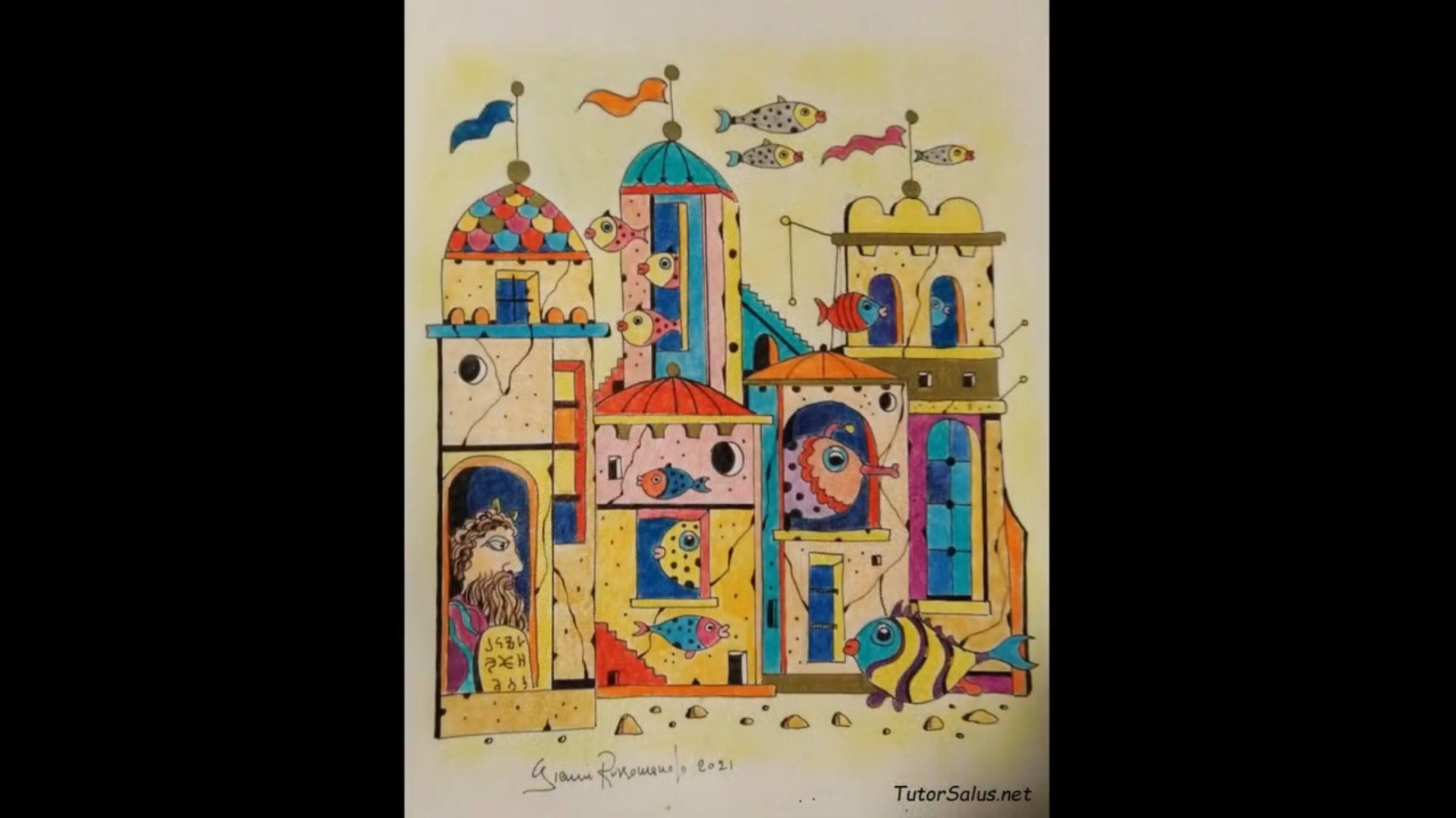“I am who I am!” (1)
Meeting history, ‘Moses by Michelangelo’ Buonarroti (2)

Original painting by Gianni Russomando[3]. Ref.: 0_5524211_125008.jpg
“Psychoanalysis is used to get deep into secrets and hidden items, relying on elements not so appreciated or realized, that is what our observation did reject”[4].
Freud became fond of the essay on Moses by Michelangelo, up to coming back often and up to that ‘L’uomo Mosè e la religione monoteistica’ which was his last book, edited in 1939 : he began asking to himself what ever in that huge statue was able to recall him so strongly.
In some evidence, it was already on which he was working, as the work by Michelangelo did offer to Freud just the packing of a thought that maybe could have been real life. There was something asking Freud, not so logical in Moses gesture but it didn’t seem a mistake by the author, as he was already conscious about his own authority in translating a hystoric special flash on which the Old Testament still didn’t pronounce.
“If in that Moses his half left of bear is under pressure of the forefinger of the right hand, that’s can be intended as the ‘residual’ contact between the right hand and the left part of bear, a contact that – previously to what Michelangelo has drawn – was much more tightened”[5]. There is still infact a residual fury in that huge man, promoter – also contested – of an exodus which revealed its safeguard : Moses has just learned his fellows are abandoning him, tired or maybe jealous of his speking directly to God.
“Moses express his fury… in gesture directed against his own body (the forefinger against his bear – note by redactor)… Then a change intervenes, tha hand… has been rushly shrinked and the tighten relaxed… Just a moment, the tables will have to round again on their support, fall to the ground… and crack.”[6]
Freud perfectly understood that only a previous twistling of Moses bust – of which Michelangelo was leaving its residual – made as logical that pending immobility of the statue : and he commissioned three drawings in a sequence that – just as in a relenting video – could well show the study and following result by Michelangelo.
The gesture, that attitude in Moses, his own behaviour in history couldn’t be neither realized nor used without referring to what soon before preceeded by considering its own unusefulness and damage too.
A ‘psychic good shift’ then, was the alternative to the traditional ‘sublimation’ by Moses and, in the freudian science, also safe choose to pathological destiny of an ignored affect : here it is the Freud intuition which opens to a quality shift on ‘pulsion’ science, confirmed by following criticisms too.
“…The right hand comes back and abandons the bear… then the hand gets to the tables and supports them… The unusual mix (the bear, the hand and the two tables staying – note by redactor) derives from that unique passioned hand gesture and its well justified consequences…”[7]
“He won’t throw away the tables to crack against the stones, just beacause due to them he domined his own fury, in order to save them he checked his passion… He remembered his mission and renounced to satisfy his affect (i.e. his fury - note by drawer)... In this position he remained when Michelangelo draw and sculptured him as the keeper of mausoleum .”[8]
“At last Moses does doubt about his presumed illimitate authonomy : he recognize his mistake – and consequences he already had to pay, up to acknowledge the reality of a presence with whom maybe he can work together”.[9]
Marina Bilotta Membretti, Cernusco sul Naviglio June 3, 2021
[1] “Mosè Gesù Freud”, by Giacomo B.Contri, Collana ‘Pensiero di natura’ SIC Edizioni 2007, Nota 3 p.16 : “…Without any doubt he (Freud, ndr) didn’t accept the said ‘Seventies’ translation about a well known passage in ‘Exodus’ 3, 14 when Hebraic language has been forced till Saint says to Moses : ‘I am the one he is, or : who is being or the being rather than ‘I am who I am!’, so near to earth and human”.
[2] “Il Mosè di Michelangelo”, by Sigmund Freud (1913-1914) Biblioteca Bollati Boringhieri (1976, 2020) : it was edited anonymous in its first edition (1914) on the magazine ‘Imago’, directed by Freud himself. ‘Moses’ in San Pietro in Vincoli church (Rome) is by Michelangelo : the project was commissioned for a future monument for the death of Julius II, and was begun in 1513 as the pope dead, then finished by Michelangelo only around 1542.
[3]Gianni Russomando, biography : “I’m born in Vercelli (1956). Graduated at ‘Istituto di Belle Arti di Vercelli’, I can describe me as a simple ‘amanuense’ (medieval hand-painter). Far from expositions and competitions, it’s not a long time I’m on social media with a very personal aim : to give just a flash of joyful to anyone watching at my simple works.”
[4] “Il Mosè di Michelangelo”, by Sigmund Freud (1913-1914) Biblioteca Bollati Boringhieri (1976, 2020), p.37
[5] “Il Mosè di Michelangelo”, by Sigmund Freud (1913-1914) Biblioteca Bollati Boringhieri (1976, 2020), p.40
[6] “Il Mosè di Michelangelo”, by Sigmund Freud (1913-1914) Biblioteca Bollati Boringhieri (1976, 2020, p.41-45
[7] “Il Mosè di Michelangelo”, by Sigmund Freud (1913-1914) Biblioteca Bollati Boringhieri (1976, 2020, p.46
[8] “Il Mosè di Michelangelo”, by Sigmund Freud (1913-1914) Biblioteca Bollati Boringhieri (1976, 2020, p.48-49
[9] It is a part of my intervention in classroom, in the Seminary ‘Letture freudiane col pensiero di natura’, Urbino 2017 – ‘Questioni controverse’/ work session ‘Meta’ 11 marzo 2017, ‘Il Mosè di Michelangelo’ (S.Freud 1914)

